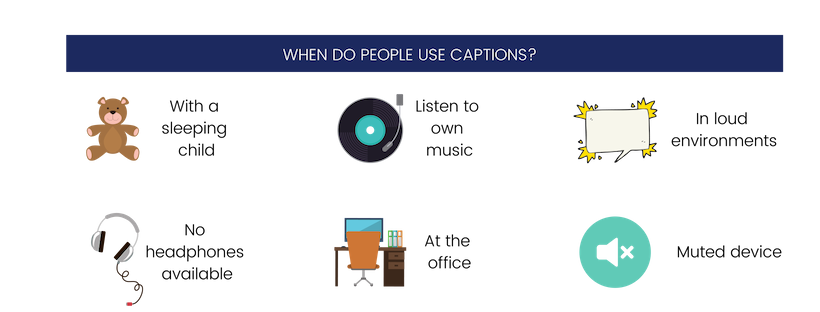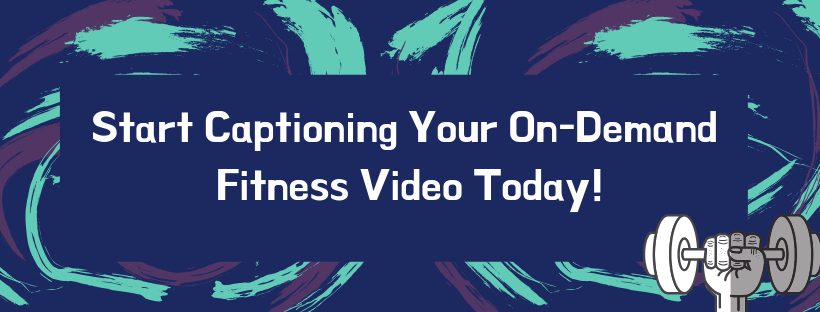The Benefits of Captioning On-Demand Fitness Video
Updated: May 1, 2020
The health and fitness industry continues to prosper as Americans become more conscious of their health and make better long-term investments in their overall well-being.
A growing number of people are leaving their gym memberships behind and opting for an at-home fitness experience. The modern fitness routine incorporates home equipment, customized workout plans, and personalized wellness tips. The total package for the busy individual who’s always on-the-go (which honestly, is most of us).
Before on-demand fitness video became mainstream, if someone couldn’t find time to get to the gym, they probably wouldn’t exercise. Now you can stream a class anywhere you want, including in the comfort of your own home – before work, at lunchtime, or even late at night.
The convenience of on-demand workouts, access to elite instructors, and the ability to connect with other members from around the world has empowered millions of people to choose a fitness plan that works for them.
With over 318,000 health and fitness apps on the market, how does your brand stand out amongst the rest? Captioning on-demand fitness video allows your content to reach a wider audience while keeping them engaged for longer.
Accessibility for Viewers Who Are d/Deaf or Hard of Hearing
Closed captions accommodate individuals who are d/Deaf or hard of hearing.
There are over 466 million people worldwide with some form of hearing loss, and captioning on-demand fitness video makes your content accessible.
“71% of people with disabilities leave a website immediately if it is not accessible.”
Online fitness companies want their videos to reach as many people as possible, but did you know that 71% of people with disabilities leave a website immediately if it is not accessible?
If brands don’t provide closed captions, there’s a very high chance that many people won’t view their content. Failing to offer closed captioning not only excludes millions of people, but it hinders brands from reaching a whole market of potential customers.
Additionally, many classes in the traditional gym setting are not accessible to d/Deaf and hard of hearing people. These classes are typically led by a trainer who verbally instructs members making it completely incomprehensible to individuals with hearing loss.
On-demand fitness video, that is accurately captioned, is a great alternative for people with sensory disabilities who aren’t able to fully participate in an in-person live class.
Legal Compliance: Accessibility is a Civil Right
There’s a rising trend of companies being sued for having inaccessible websites. Online brands like Netflix, Hulu, and Amazon have all been sued for violating the Americans with Disabilities Act (ADA).
The ADA was enacted in 1990 to protect disabled citizens from discrimination. At the time, the internet wasn’t as widespread as it is today so the law didn’t specify online businesses. As of today, many brands can learn from recent lawsuits that accessibility is important. A web accessibility strategy should be put in place to accommodate viewers who may have a disability.
Captioning on-demand fitness video should be a priority and not an afterthought. This can protect your brand from potential lawsuits and make your content visible to the many people who want to engage with your content.
Increase Video SEO
Search engine optimization, otherwise known as SEO, is the process of attracting visitors to your website through organic search engine results. While video SEO is a similar concept, it requires some different tactics.
An online video usually has a title and description, however, the content itself remains hidden to search bots. Search engines are not able to watch a video, but they certainly can read text. When you caption a video, the text version is available for search engines to crawl for relevant keywords, ensuring your video is properly indexed.
Captions increase video viewership. A study by Facebook found that captions increase video views by 12%.
With captions, search engines know exactly what your video is about. Thus, your video can rank higher for more keywords and be discovered by more people.
Flexibility in Sound Sensitive Environments
Another benefit of captioning on-demand fitness video is that it helps viewers enjoy content in sound-sensitive environments. Thanks to the portability of our devices, we’re able to watch video virtually anywhere.
Sometimes people workout in environments that are noisy and need an option for when the sound is unclear. Many people even like to listen to their own music when they work out. Captions allow members to mute their devices, and workout to the music of their choice.
In contrast, some people workout in quiet environments and don’t have headphones. For example, there may be a parent who wants to work out with a sleeping child present.
Captions are a great way to make your video enjoyable when sound isn’t available. 41% of videos are incomprehensible without sound or captions, which means that if someone doesn’t have access to headphones, they won’t be able to understand your content.
Improve User Engagement
As mentioned, captions are a great accommodation for viewers with disabilities, however, many people who enjoy captions don’t have hearing loss. According to the United Kingdom’s Ofcom, 80% of people who watch videos with closed captions are not d/Deaf or hard of hearing.
When brands make deliberate choices to make the user experience as seamless as possible, it increases user engagement. Captioning on-demand fitness video keeps users engaged and focused because when there is difficult language, poor audio quality, or complex information, captions help with clarification.
Download The Infographic: The Ultimate Guide to Video Engagement
Translations for a Global Audience
We live in a globalized world, where it’s easy to connect with people who live in different countries. In addition, video can be viewed anywhere as long as there’s an internet connection.
Brands can no longer limit themselves to a specific country or region since users from all over the world can access your content. Your content should also be accessible to the millions of international viewers as well.
If you already have captions, it’s much easier to create translations in other languages and help your content reach a wider audience!
Ready to see the benefits for yourself? Get started with 3Play today!
Further Reading

Subscribe to the Blog Digest
Sign up to receive our blog digest and other information on this topic. You can unsubscribe anytime.
By subscribing you agree to our privacy policy.









